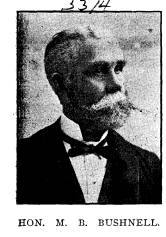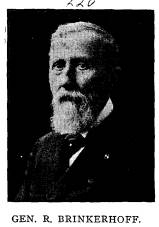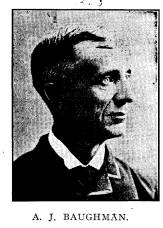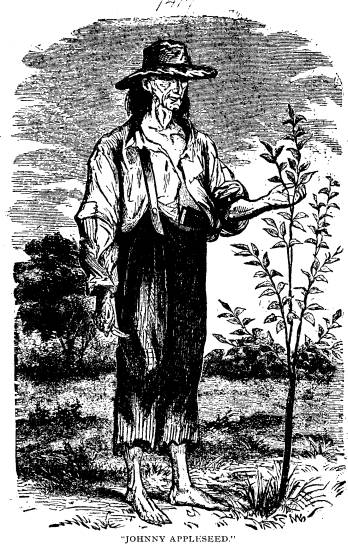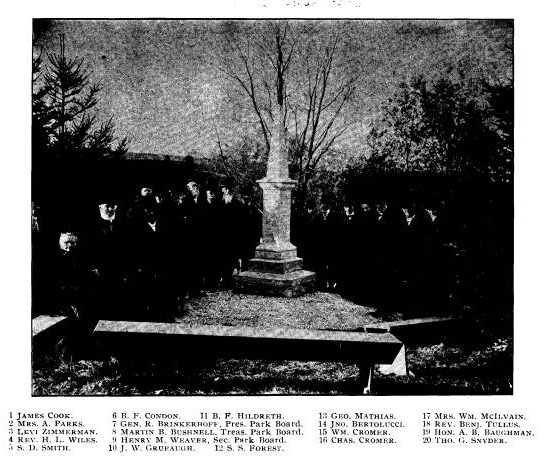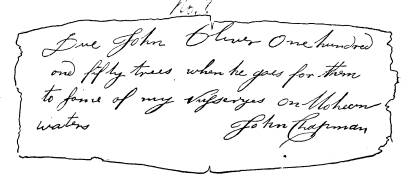Ohio History Journal
|
"JOHNNY APPLESEED"-JOHN CHAPMAN.
HIS MEMORY HONORED WITH A MONUMENT AT MANSFIELD, 0. Exercises of a unique and interesting character were held at Mansfield, Ohio, on the afternoon of November 8, 1900. It was the dedication in the Sherman-Heineman Park of the mon- ument to the memory of John Chapman, otherwise and more |
|
|
|
pioneer nurseryman of Richland county from 181O to 1830.", On the opposite side are the names of the Park Commissioners. "Martin B. Bushnell, Henry M. Weaver and Roeliff Brinker- hoff, Sr., 1900." The dedicatory ceremonies were by invitation of the Park Commissioners conducted under the auspices of the Historical Society of Richland county, the members of which, in addition to the city officials, were specially invited to be present. The invocation was pronounced by the Rev. Dr. H. L. Wiles, of the First Lutheran Church. General Roeliff Brinker- hoff, one of the Park Commissioners, and President of the Ohio State Archaeological Society, then made the following address: *The gentleman who erected the monument to the memory of "Johnny Appleseed" in the Sherman-Heineman Park at Mansfield, O. (303) |
|
304 Ohio Arch. and His. Society Publications.
ADDRESS OF GENERAL BRINKERHOFF. General Roeliff Brinkerhoff, of the Board of Park Commis- sioners, in his address spoke as follows: We have met here today to dedicate a monument to one of the earliest and most unselfish of Ohio benefactors. His name was John Chapman, but to the pioneers he was everywhere |
|
|
known as "Johnny Appleseed." The field of his operations, in Ohio, was mainly, the valleys of the Muskin- gum river and its tributaries and his mission, for the most part, was to plant apple seeds in well located nurseries, in advance of civilization and have apple trees ready for plant- ing when the pioneers should appear. He also scattered through the forest the seeds of medicinal plants, such as dog-fennel, pennyroyal, cat- nip, hoarhound, rattlesnake root and the like. We hear of him as early as 1806 |
|
on the Ohio river, with two canoe loads of appleseeds gathered from the cider presses of western Pennsylvania and with these he planted nurseries along the Muskingum river and its trib- utaries. About 1810 he made his headquarters in that part of the old county of Richland, which is now Ashland, in Green township, and was there for a number of years and then came to Mans- field. He was a familiar figure and a welcome guest in the homes of the early pioneers. All the early orchards of Richland county were procured from the nurseries of "Johnny Appleseed." Within the sound of my voice, where I now stand, there are a dozen or more trees that we believe are the lineal descendants of "Johnny Appleseed's" nurseries. In fact, this monument is almost within the shadow of three or four of them. As civilization advanced "Johnny" passed on to the west- ward and at last, in 1847, he ended his career in Indiana and was |
|
"Johnny Appleseed." 305
buried near what is now the city of Fort Wayne. To the end he was true to his mission of planting nurseries and sowing the seeds of medicinal herbs. To the pioneers of Ohio he was an unselfish benefactor and we are here today to aid in transmitting to coming generations our grateful memory of his deeds.
HISTORICAL SKETCH. The historical sketch of "Johnny Appleseed" was prepared and presented by Mr. A. J. Baughman, a recognized authority in the early history of Richland county. Mr. Baughman's address was as follows: John Chapman was born at Springfield, Mass., in the year 1775. Of his early life but little is known, as he was reticent |
|
|
about himself, but his half-sister, who came west at a later period, stated that Johnny had, when a boy, shown a fondness for natural scen- ery and often wandered from home in quest of plants and flowers and that he liked to listen to the birds singing and to gaze at the stars. Chapman's penchant for planting apple seeds and cultivating nur- series caused him to be called "Appleseed John," which was finally changed to "Johnny Apple- seed," and by that name he was called and known everywhere. |
|
The year Chapman came to Ohio has been variously stated, but to say it was one hundred years ago would not be far from the mark. An uncle of the late Rosella Rice lived in Jefferson county when Chapman made his first advent into Ohio, and one day saw a queer-looking craft coming down the Ohio river above Steubenville. It consisted of two canoes lashed together, and its crew was one man-an angular oddly-dressed person-and when he landed he said his name was Chapman, and that his cargo consisted of sacks of apple seeds and that he intended to plant nurseries. |
306 Ohio Arch. and His.
Society Publications.
Chapman's first nursery was planted nine
miles below Steu-
benville, up a narrow valley, from the
Ohio river, at Brilliant,
formerly called Lagrange, opposite
Wellsburg, W. Va. After
planting a number of nurseries along the
river front, he extended
his work into the interior of the
state-into Richland county-
where he made his home for many years.
Chapman was enterprising in his way and
planted nurseries
in a number of counties which required him to travel hundreds
of miles to visit and prune them yearly, as was his custom. His
usual price for a tree was "a fip
penny-bit," but if the settler
hadn't money, Johnny would either give
him credit or take old
clothes for pay. He generally located
his nurseries along
streams, planted his seeds, surrounded
the patch with a brush
fence, and when the pioneers came, Johnny had young fruit
trees ready for them. He extended his operations to the Mau-
mee country and finally into Indiana,
where the last years of his
life were spent. He revisited Richland county the last time
in
1843, and called at my father's, but as
I was only five years old
at the time I do not remember him.
My parents (in about 1827-'35) planted
two orchards with
trees they bought of Johnny, and he
often called at their house,
as he was a frequent caller at the homes of the settlers. My
grandfather, Captain James Cunningham,
settled in Richland
county in 1808, and was acquainted with Johnny
for many years,
and I often heard him tell, in his
Irish-witty way, many amusing
anecdotes and incidents of Johnny's life
and of his peculiar and
eccentric ways.
Johnny was fairly educated, well read
and was polite and
attentive in manner and was chaste in
conversation. His face
was pleasant in expression, and he was
kind and generous in
disposition. His nature was a deeply
religious one, and his life
was blameless among his fellow men. He
regarded comfort
more than style and thought it wrong to
spend money for cloth-
ing to make a fine appearance. He usually wore a broad-
brimmed hat. He went barefooted not only
in the summer, but
often in cold weather, and a coffee
sack, with neck and armholes
cut in it was worn as a coat. He was
about 5 feet, 9 inches in
|
"Johnny Appleseed." 307 height, rather spare in build, but was large boned and sinewy. His eyes were blue, but darkened with animation. For a number of years Johnny lived in a little cabin near Perrysville (then in Richland county), but later he made his |
|
|
308
Ohio Arch. and His. Society Publications.
home in Mansfield with his half-sister,
a Mrs. Groome, who lived
on the Leesville road (now West Fourth
street) near the present
residence of R. G. Hancock. The parents
of George C. Wise
then lived near what is now the corner
of West Fourth street
and Penn avenue and the Groome and Wise
families were
friends and neighbors. George C. Wise,
Hiram R. Smith, Mrs.
J. H. Cook and others remember
"Johnny Appleseed" quite well.
Mrs. Cook was, perhaps, better
acquainted with "Johnny" than
any other living person today, for the
Wiler House was often his
stopping place. The homes of Judge
Parker, Mr. Newman and
others were ever open to receive
"Johnny" as a guest.
But the man who best understood this peculiar
character
was the late Dr. William Bushnell,
father of our respected fellow-
townsman, the Hon. M. B. Bushnell, the
donor of this beautiful
commemorative monument, and by whose
kindness and liber-
ality we are here today. With Dr.
Bushnell's scholastic attain-
ments and intuitive knowledge of
character he was enabled to
know and appreciate Chapman's learning
and the noble traits of
his head and heart.
When upon his journeys
"Johnny" usually camped out.
He never killed anything, not even for
the purpose of obtaining
food. He carried a kit of cooking
utensils with him, among
which was a mush-pan, which he sometimes
wore as a hat.
When he called at a house, his custom
was to lie upon the floor
with his kit for a pillow and after
conversing with the family a
short time, would then read from a
Swedenborgian book or
tract, and proceed to explain and extol
the religious views he
so zealously believed, and whose
teachings he so faithfully car-
ried out in his every-day life and
conversation. His mission
was one of peace and good will and he
never carried a weapon,
not even for self-defense. The Indians
regarded him as a great
"Medicine Man," and his life
seemed to be a charmed one, as
neither savage men nor wild beast would
harm him.
Chapman never married and rumor said
that a love affair in
the old Bay State was the cause of his
living the life of a celibate
and recluse. Johnny himself never
explained why he led such
a singular life except to remark that he
had a mission-which
was understood to be to plant nurseries
and to make converts to
"Johnny Appleseed." 309
310
Ohio Arch. and His. Society Publications.
watchman on the walls of Jezreel,"
to guard and protect the set-
tlers from their savage foes.
The journey to Mt. Vernon was a sort of
a Paul Revere
mission. Unlike Paul's
"Johnny's" was made on foot-bare-
footed-over a rough road, but one that
in time led to fame.
"Johnny" would rap on the
doors of the few cabins along
the route, warn the settlers of the
impending danger and advise
them to flee to the block-house.
"Johnny" arrived safely at Mt.
Vernon, aroused the gar-
rison and informed the commandant of his
mission. Surely,
figuratively speaking,
"The dun-deer's hide
On fleeter feet was never tried,"
for so expeditiously was the trip made
that at sunrise the next
morning troops from Mt. Vernon arrived
at the Mansfield block-
house, accompanied by
"Johnny," who had made the round trip
of sixty miles between sunset and
sunrise.
About a week before Chapman's death,
while at Fort
Wayne, he heard that cattle had broken
into his nursery in St.
Joseph township and were destroying his
trees, and he started
on foot to look after his property. The distance was about
twenty miles and the fatigue and
exposure of the journey were
too much for "Johnny's"
physical condition, then enfeebled by
age; and at the even-tide he applied at
the home of Mr. Worth
for lodging for the night. Mr. Worth was
a native Buckeye
and had lived in Richland county when a
boy, and when he
learned that his oddly-dressed caller
was "Johnny Appleseed"
gave him a cordial welcome.
"Johnny" declined going to the
supper table, but partook of a bowl of
bread and milk.
The day had been cold and raw with
occasional flurries of
snow, but in the evening the clouds
cleared away and the sun
shone warm and bright as it sank in the
western sky. "Johnny"
noticed this beautiful sun-set, an
augury of the spring and
flowers so soon to come and sat on the
doorstep and gazed with
wistful eyes toward the west. Perhaps
this herald of the spring
time, the season in which nature is
resurrected from the death
of winter, caused him to look with
prophetic eyes to the future
"Johnny Appleseed." 311
and contemplate that glorious event of
which Christ is the res-
urrection and the life. Upon re-entering
the house, "Johnny"
declined the bed offered him for the
night, preferring a quilt
and pillow on the floor, but asked
permission to hold family
worship and read "Blessed are the
poor in spirit, for theirs is
the kingdom of Heaven,"
"Blessed are the pure in heart, for
they shall see God," etc.
After he had finished reading the
lesson, he said prayers-
prayers long remembered by that family.
He prayed for all
sorts and conditions of men; that the
way of righteousness might
be made clear unto them and that saving
grace might be freely
given to all nations. He asked that the
Holy Spirit might guide
and govern all who profess and call
themselves Christians and
that all those who were afflicted in
mind, body or estate, might
be comforted and relieved, and that all
might at last come to the
knowledge of the truth and in the world
to come have happiness
and everlasting life. Not only the words
of the prayer, but the
pathos of his voice made a deep
impression upon those present.
In the morning "Johnny" was
found in a high state of fever,
pneumonia having developed during the
night, and the physi-
cian called said he was beyond medical
aid, but inquired partic-
ularly about his religious belief, and
remarked that he had never
seen a dying man so perfectly calm, for
upon his wan face there
was an expression of happiness and upon
his pale lips there was
a smile of joy, as though he was
communing with loved ones
who had come to meet him and to soothe
his weary spirit in his
dying moments. And as his eyes shone
with the beautiful light
supernal God touched him with his finger
and beckoned him
home.*
* John Chapman was buried at Ft. Wayne,
Indiana, in the year 1847,
according to the history of Richland
county, by A. A. Graham (page
266). He had been a resident of that
vicinity for some seventeen years.
He was buried by Mr. Worth and neighbors
in David Archer's grave
yard, two and one-half miles north of
Ft. Wayne. A letter of October
4, 19OO, from John H. Archer, grandson of David Archer,
states that
the account in Mr. Graham's history is
practically correct. John Archer
says in his letter:
"During his life and residence in
this vicinity I suppose that every
man, woman and child knew something of
"Johnny Appleseed." I find
312 Ohio Arch. and His. Society Publications.
Thus ended the life of the man who was
not only a hero,
but a benefactor as well; and his spirit
is now at rest in the Par-
adise of the Redeemed, and in the
fullness of time, clothed
again in the old body made anew, will
enter into the Father's
house in which there are many mansions.
In the words of his
own faith, his bruised feet will be
healed, and he shall walk on the
gold-paved streets of the New Jerusalem
of which he so elo-
quently preached. It has been very appropriately said that
although years have come and gone since
his death, the memory
of his good deeds live anew every
springtime in the beauty and
fragrance of the blossoms of the apple
trees he loved so well.
"Johnny Appleseed's" death was
in harmony with his unos-
tentatious, blameless life. It is often
remarked, "How beau-
tiful is the Christian's life; yea, but
far more beautiful is the
Christian's death," when "the
fashion of his countenance is
altered," as he passes from the
life here to the life beyond.
What changes have taken place in the
years that have inter-
vened between the "Johnny
Appleseed" period and today! It
has been said that the lamp of
civilization far surpasses that of
Aladdin's. Westward the star of empire
took its way and
changed the forests into fields of grain
and the waste places into
gardens of flowers and towns and cities
have been built with
marvelous handiwork. But in this march
of progress the strug-
gles and hardships of the early settlers
must not be forgotten.
Let us not only record the history, but
the legends of the pioneer
period; garner its facts and its
fictions; its tales and traditions
and collect even the crumbs that fall
from the table of the feast.
that there are quite a number of persons
yet living here that remem-
ber him well and enjoy relating
reminiscences and peculiarities of his
habits and life. The historical account
of his death and burial by the
Worths and their neighbors, the Pettits,
Goinges, Porters, Notestems,
Parkers, Beckets, Whitesides, Pechons,
Hatfields, Parrants, Ballards,
Randsells and the Archers in David
Archer's private burial grounds is
substantially correct. The grave, more
especially the common head-
boards used in those days, have long
since decayed and become entirely
obliterated, and at this time I do not
think that any person could with
any degree of certainty come within
fifty feet of pointing out the loca-
tion of his grave. Suffice it to say that he has been
gathered in with
his neighbors and friends, as I have
enumerated, for the majority of them
lie in David Archer's graveyard with him."
"Johnny Appleseed." 313
To-day, the events which stirred the
souls and tried the
courage of the pioneers seem to come out
of the dim past and
glide as panoramic views before me. A
number of the actors
in those scenes were of my "kith
and kin" who have long since
crossed over the river in their journey
to the land where Enoch
and Elijah are pioneers, while I am left
to exclaim:
"Oh, for the touch of a vanished
hand
And the sound of a voice that is still."
While the scenes of those pioneer days
are vivid to us on
history's page, future generations may
look upon them as the
phantasmagoria of a dream.
At 72 years of age-46 of which had been
devoted to his
self-imposed mission-John Chapman
ripened into death as nat-
urally and as beautifully as the apple
seeds of his planting had
grown into trees, had budded into
blossoms and ripened into
fruit. The monument which is now to be
unveiled is a fitting
memorial to the man in whom there dwelt
a comprehensive love
that reached downward to the lowest
forms of life and upward
to the throne of the Divine.
At the close of Mr. Baughman's address
the monument was
unveiled by Major Brown, of Mansfield,
after which a quartet,
consisting of Charles H. Harding, Dr. C.
N. Miles, Major Fred
S. Marquis and E. W. Dann, sang
"Onward and Upward," and
the exercises closed with the singing by
all present of "America."
"JOHNNY APPLESEED" ADDENDUM.
E. O. RANDALL, EDITOR.
From several sources, more or less
authentic, much interest-
ing information may be collated
concerning "Johnny Apple-
seed." He pursued his special
calling for many years through-
out the central and eastern portions of
Ohio, particularly in
Knox, Richland, Wayne and Ashland
counties, or in the territory
since known as these counties, and it is
from the histories of
these counties that we rely largely for
fragmentary descriptions
314 Ohio Arch. and His.
Society Publications.
of the peculiar personality and
eccentric experiences of John
Chapman.
The early history of John Chapman is
veiled in obscurity
and for some unknown reason he never
disclosed the events of
his youth. He was of New England
ancestry and undoubtedly
well educated, for he was a good reader
and a ready talker,
indeed at times is said to have been
eloquent, especially when
discoursing upon "fine fruit and
the spiritual theories of his
beloved Swedenborg," whose beliefs
he espoused.
Aside from his odd hobby of planting
apple seeds, which
was probably the origin of the first
nurseries in this part of the
country, as well as the means of
supplying the pioneers with that
popular and nutritious fruit, John
Chapman was interesting
because of his strange habits, fantastic
mode of attire, and
unique manner of living. His clothing
was sparse, singular and
generally antique. He claimed that man
should only be clothed
to conceal his nakedness and not for
comfort, much less display.
His wardrobe was usually but the second
hand refuse garments
which he had taken in exchange for young
apple trees. At times
his main garment consisted of a coffee
sack, through apertures
of which he might thrust his head and
arms. On one occasion
it is reported a pair of shoes was given
him which shortly after-
wards he offered to a barefooted western
traveler, who he said
needed them worse than he. For a hat or
covering he wore
for a long time a tin pan, which he
would use, as occasion re-
quired, in the cooking of his frugal
meal. This was subse-
quently superseded by a head covering of
a pasteboard "tile" so
cut as to give a wider rim on one side
than the other, this to
protect his features from the glare of
the sun. In this anom-
alous attire he traversed the country
visiting the natives for the
purpose of plying his appleseed
profession. His gentleness of
manner and generosity of disposition,
always made him a wel-
come guest wherever he was known, and
whenever he would
accept hospitality, which was seldom.
But in his ideas of living
and of society he was the pioneer
Thoreau of his times. He
preferred to live alone. He enjoyed the
solitude of the woods
and the companionship of the forest
animals rather than that of
a fellow-man. While traversing the woods
in which he spent
|
"Johnny Appleseed." 315
a large part of his time, he carried with him an axe, a hatchet and a Virginia hoe, with which he cleared the underbrush, and dug in the loamy or rich soil, usually along the banks of some stream. In these cleared spots he would plant his apple seeds and start a nursery. While most of this work was done pro bono publico it was also his only source of subsistence. With a restless and roving disposition he kept moving from point to point scattering his nurseries along the streams or highways for even hundreds of miles. He seldom sold his wares for money, but usually exchanged them for such articles of clothing or food as he actually needed. We were so fortunate as to obtain an auto- graph order of John Chapman, which we here produce. |
|
|
|
His diet was that of the vegetarian. His meals consisted of berries, nuts, the native fruits of the country and little corn bread or mush made from meal, for which he had traded a handful of apple seeds. In philosophy he was a stoic, and assumed to bear pain with stolid indifference. If he bruised or wounded his foot among stones or thorns, it is said his first remedial application was a red hot iron to the afflicted part, by which it was seared. He was an intense lover of every variety of God's creatures, and to kill even the most repellant or useless form of animal life for any purpose, was to him a sin. If he saw an animal maltreated, or heard of it, he would buy it and give it to some more humane settler, with the condition that it be kindly treated. He de- served to be the patron saint of the Humane Society, of which |
316
Ohio Arch. and His. Society Publications.
he was certainly the earliest
forerunner. Emigrants who trav-
eled from the east to the west passing
in his vicinity would
often cast off their decrepit or worn
out horses, leaving them
to starve or forage for themselves. As
the blight of winter
drew near, Chapman would corral these
outcast brutes and
bargain for their care and protection
with some farmer until the
coming spring. It is further recorded
that he would never sell
these poor and despised animals, but if
any of them recovered
their strength, so as to be valuable, he
would lend them or give
them away, exacting a promise from the
recipient that the dumb
beast should ever receive kind
treatment. This sympathy with
the lower life and sacred respect for
its existence was carried in
"Johnny Appleseed" to an
almost preposterous extent. At one
time in relating the circumstance of
being bitten by a rattle snake
he said: "Poor fellow, he only just
touched me when I in the
heat of my ungodly passion put the heel
of my scythe in him
and went away. Some time afterward I
went back and there
lay the poor fellow dead." That
death was the cause of deep
regret to Johnny, and he never referred
to it without the feeling
of great sorrow. At one time when
camping out he kindled a
fire for the comforts of home, when he
noticed that the blaze was
a drawing card for a large audience of
mosquitoes, "seeking
whom they might devour." Many of
these naturally were lured
into the flames and burned. Chapman,
without delay, brought
water from a near stream or spring and
extinguished the fire,
saying, "God forbid that I should
build a fire for my comfort
which should be the means of destroying
any of his creatures."
At another time he started a fire near a
hollow log in the dead
of winter, when he discovered that
within the log a bear and
cubs had taken refuge. Rather than
disturb the peaceful slum-
bers of bruin and family he put out the
fire and spent the night
upon the snow. Many similar instances
might be related of his
self-sacrifice and even endangerment of
life, in behalf of the pro-
tection and preservation of the humblest
creatures of the prime-
val forest. The most cursory knowledge
of the life and belief of
"Johnny Appleseed" is
convincing as to his innate tenderness of
heart and childlike simplicity of faith.
He loved nature in all
her forms with a passionate devotion. It
is everywhere to be
"Johnny Appleseed." 317
inferred, where not actually stated,
that in spite of his grotesque
apparel, unnatural manner of living and
crude method of dealing,
he was nevertheless greatly respected by
all who came in con-
tact with him. Indeed some of his would
be biographers have
the testimony of those who knew him,
that he was a man of
strong character, deep philosophy, and
solely impelled by the
motives of humanity and
benevolence. His religious tenets,
such as they were, were not
"orthodox," but were the essence
of primitive Christianity, namely, love
thy neighbor as thyself.
Like Thoreau, he did not wish to acquire
property. He had
no use for worldly goods. He constantly
gave away, for the
welfare of others, whatever possessions
he might acquire. His
purchase of three acres of land in
Ashland county-in what is
now known as the little town of Lake
Fork-is the single and
isolated instance in which Chapman ever
invested any surplus
capital in real estate. It is an odd
sequence that the deed to
Chapman was lost before being recorded,
and the tract was
never transferred upon the Auditor's
books. Chapman started a
nursery upon the land, which, upon his
leaving it, passed to other
hands through the defect in the title.
John Chapman was a
marvelous and paradoxical mixture of
noble and unconventional
traits. It is a pity that we have not a
complete account of his
life replete as it undoubtedly was with
good deeds. He was a
benefactor of his race. He served his
day and generation to the
best of his ability and opportunity. No
man could do better.
So he kept traveling, far and wide,
"Till his old limbs failed him and
he died.
He said, at last: "'Tis a comfort
to feel
I've done some good in the world, though
not a great deal."
Weary travelers, journeying West,
In the shade of his trees find pleasant
rest.
And often they start with glad surprise
At the rosy fruit that around them lies.
And if they inquire whence came such
trees,
Where not a bough once swayed in the
breeze,
The reply still comes, as they travel
on,
"These trees were planted by
Appleseed John."
(From the poem "Appleseed
John," by Lydia Maria Child.)
